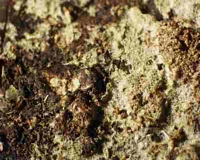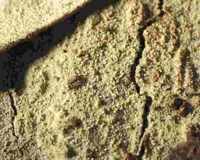|
 Hyphodontia subalutacea Hyphodontia subalutacea
SynonymsTubulicrinis subalutaceus
Corticium subalutaceum
BiostatusPresent in region - Indigenous. Non endemic
Images (click to enlarge)
Caption: Hyphodontia subalutacea, BCP 1850
Owner: B.C. Paulus | 
Caption: Hyphodontia subalutacea, BCP 1850
Owner: B.C. Paulus |
Article: Cunningham, G.H. (1963). The Thelephoraceae of Australia and New Zealand. New Zealand Department of Scientific and Industrial Research, Bulletin 145: 359 p. Wellington:.
Description: Hymenophore annual, membranous, adherent, effused forming irregular
areas to 12 x 4 cm; hymenial surface dingy white or pallid ochre, granular,
farinose, not creviced; margin thinning out, arachnoid, white, adherent. Context
white, 50-150 µm thick, basal layer of a few repent hyphae, intermediate layer
of loosely arranged mainly ascending hyphae more freely branched in the
subhymenium; generative hyphae 3-3.5 µm diameter, walls 0.2 µm thick, hyaline,
naked, with clamp connections, Cystidia arising from the base of the
intermediate layer, projecting to 65 µm, cylindrical or slightly expanded from
bases to apices, 80-130 x 6-8 µm, walls naked, thickened basally to 2.5 µm,
becoming thinner towards the often collapsed apices. Hymenial layer to 20 µm
deep, a scanty palisade of basidia, paraphyses, and cystidia. Basidia
subclavate, 10-18 x 4-5 µm, bearing 4 spores; sterigmata erect, to 5 µm long.
Paraphyses subclavate, 8-12 x 3-4 µm. Spores cylindrical or allantoid, with
rounded ends, 6-9 x 2-2.5 µm, walls smooth, hyaline, 0.1 µm thick; often
adhering in fours.
Habitat: HABITAT: Effused on bark or decorticated
wood of dead branches.
Distribution: DISTRIBUTION: Europe, Great Britain, North America,
New Zealand.
Notes: Cystidia are expanded
slightly from bases to apices, and walls become thickened progressively from
apices to bases. In several collections they are arranged in clusters in small
spines, so that the species might be sought under Odontia of the
Hydnaceae; but in other particulars are identical with even collections listed.
Spores are allantoid, some cylindrical, and in shape resemble those of T.
gracillima.
|